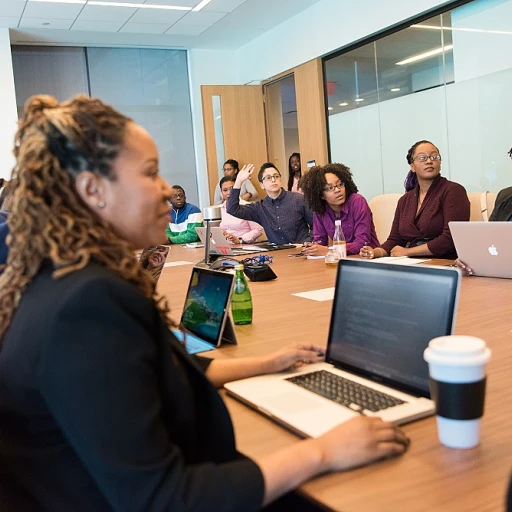Understanding the Essence of a Workforce Management Vision
Defining the Foundation of Workforce Management
Understanding the essence of a workforce management vision is vital to achieving a cohesive and resilient organization. A well-articulated vision not only directs efforts but also ensures all aspects of the workforce, from recruitment to retention and employee engagement, are aligned with broader strategic goals.
A workforce vision strengthens the connection between an organization’s objectives and its human capital management. This vision becomes the guiding compass, helping to maneuver through challenges while fostering employee engagement and enhancing customer experience. It's especially critical in the context of our modern workforce, which requires adaptability to changes and a long-term strategic perspective.
Businesses aiming for excellence in workforce management must consider integrating advanced workforce software and management technology. Software solutions enable real-time insights and support strategic decision-making by processing vast amounts of data with the aid of artificial intelligence and machine learning. This approach allows organizations to meet the expectations of the global workforce they serve, including the intricacies of contact center operations and customer service delivery.
To further explore strategies associated with optimizing workforce scheduling for efficiency, this comprehensive guide provides valuable insights.
Aligning Workforce Management with Strategic Goals
Integrating Organizational Strategy with Workforce Management
To effectively align workforce management with strategic goals, it is critical to bridge the gap between operational tasks and overarching business objectives. This alignment serves as the foundation for a comprehensive workforce vision, ensuring that every action taken within the workforce management plan supports the broader strategic imperatives of the organization. One key aspect is the establishment of a clear connection between the organization's strategic goals and its workforce management vision. This connection enables the workforce to be more agile, responsive, and attuned to the demands of both the market and the industry. Consider these steps:- Analyzing Business Objectives: Begin by comprehensively understanding the strategic goals of your organization. The more you understand these objectives, the better you can craft a workforce management vision that enhances workforce performance to achieve optimal results.
- Engaging Employees: Boosting employee engagement is essential for aligning workforce efforts with strategic objectives. By cultivating a robust employee experience, you can ensure that employees are motivated and aligned with your company’s vision and goals.
- Investing in Technology: Leverage workforce software and management technologies, such as artificial intelligence and machine learning, to streamline processes and improve real-time insights into workforce dynamics. This enables a more adaptive and responsive approach to management.
- Fostering Customer Satisfaction: A well-aligned workforce contributes to improved customer service and customer experience. Ensuring that employees understand their role in delivering superior service is key to aligning workforce management with strategic goals.
- Collaborating with Industry Experts: Engaging with industry experts and attending a vision conference can provide valuable insights into trending workforce and management solutions in the industry. These engagements help in crafting a workforce management vision that is not only practical but also innovative and future-ready.
Key Components of an Effective Workforce Management Vision
Components That Define an Impactful Workforce Management Vision
Crafting a clear workforce management vision is not just about setting goals; it requires integrating key components to ensure its effectiveness and adaptability. Here are the pivotal elements to consider:- Strategic Alignment: Aligning your workforce vision with the broader organizational goals ensures that every employee and every strategy is contributing to the company’s overarching objectives. This approach guarantees that the workforce is not operating in a silo but is actively driving the company forward.
- Incorporating Workforce Software and Technology: Modern workforce challenges necessitate the use of advanced technology. Workforce management software and tools that utilize machine learning and artificial intelligence can optimize employee schedules, provide real-time analytics, and improve customer experience by predicting workflow demands. Additionally, these technologies enhance employee experience by streamlining processes and providing efficient solutions in the service portal.
- Focusing on Employee Engagement: A workforce management vision should prioritize employee engagement, ensuring that workers feel valued and motivated. This can be achieved by fostering open communication, providing opportunities for professional growth, and recognizing employee achievements. Engaged employees result in improved customer service and a positive contact center experience.
- Global Workforce Considerations: In today’s interconnected world, workforce strategies must consider the nuances of a global workforce. This includes respecting cultural differences, accommodating various time zones, and ensuring diversity and inclusion.
- Implementing Effective Management Solutions: A vision should detail practical management solutions that are adaptable to industry trends and customer demands. This may involve ongoing training, attending industry conferences, and adopting best practices shared by industry experts.
Overcoming Challenges in Workforce Planning
Identifying Common Obstacles in Workforce Planning
Tackling challenges in workforce planning is akin to navigating a path strewn with potential pitfalls. Understanding the essence of a workforce management vision is crucial; however, aligning it effectively with strategic goals often becomes a daunting task.
One primary obstacle is the rapid pace of technology changes. The integration of advanced tools like workforce software and management solutions necessitates continuous updates and training. Staying abreast of the latest developments in artificial intelligence and machine learning can seem overwhelming, yet they're crucial for maintaining a competitive edge.
Ensuring Real-Time Adaptability
The modern workforce demands real-time adaptability, another significant hurdle in workforce planning. The need for swift, accurate decision-making capabilities is greater than ever. Implementing management technology that supports real-time adjustments can significantly enhance employee engagement and customer service.
This adaptability extends to accommodating the varied needs of a global workforce. A diverse employee base requires flexible solutions that respect different cultural practices and legal frameworks.
Enhancing Employee and Customer Experience
Improving both employee experience and customer engagement requires a nuanced approach. Workforce management strategies must prioritize creating a positive work environment, which in turn influences customer service outcomes. This can be achieved through targeted employee engagement initiatives, often discussed at industry conferences.
Ensuring a seamless customer experience also rests on how well the contact center and service portals are managed. Efficiently aligning technology with workforce management goals plays a crucial role in this process.
Overcoming Resource Limitations
Resource constraints, whether in time, budget, or personnel, remain a challenge in crafting an effective workforce vision. Industry experts recommend leveraging technology to maximize efficiency, even with limited resources. Rated workforce solutions can offer insights into optimizing existing capacities without overextending the organization.
As you shape a clear and robust workforce management vision, addressing these challenges head-on will be pivotal. Building solutions around these insights can foster a more agile and responsive organization, adept at navigating the complex landscape of workforce planning.
The Role of Technology in Shaping Workforce Management
The Impact of Modern Tools on Workforce Systems
In today's rapidly changing landscape, the role of technology in workforce management cannot be overstated. It acts as a catalyst, empowering organizations to navigate complexities associated with managing both global workforce and customer expectations. Industry experts emphasize that the infusion of artificial intelligence and machine learning is driving significant changes in the way organizations view and manage their workforce. Workforce management software is no longer just a tool for organizing shifts and tracking time. Instead, it serves as a comprehensive management solution that integrates real-time data analytics to enhance employee engagement and service delivery. This dynamic approach allows for a more personalized employee experience, fostering both employee and customer satisfaction.Machine Learning and Artificial Intelligence
Machine learning and artificial intelligence technologies are transforming workforce management systems. Data-driven insights acquired through these technologies enable organizations to predict workforce needs accurately, customize employee engagement strategies, and optimize customer service experiences. This advanced technology contributes to a vision of a more responsive and agile workforce, one that aligns perfectly with an organization's strategic goals.Leveraging Technology for Improved Employee Experience
The adoption of workforce software has substantially improved the employee experience by streamlining operational processes and reducing administrative burdens. Employees now benefit from seamless interactions with management systems, accessing service portals that help them efficiently manage work schedules and tasks. This empowerment is vital for maintaining high levels of employee engagement, leading to a more productive and satisfied workforce. In addition, technology allows for the development of sophisticated contact center solutions that amplify the customer experience. Through innovative customer service applications, organizations can maintain a competitive edge in the industry by delivering superior service and fostering long-lasting customer relationships.Industry Conferences Shaping the Technology Landscape
Attending a vision conference dedicated to workforce management can offer valuable insights into emerging technologies and industry trends. These events gather leading thinkers and innovators who share practical insights and real-world solutions for leveraging technology to drive better workforce outcomes. By staying informed, organizations can adapt quickly to technological advancements and maintain a competitive edge. Overall, adapting to modern workforce management technology is essential for any organization aiming to enhance their service delivery and overall employee satisfaction.Measuring the Success of Your Workforce Management Vision
Assessing Effectiveness and Making Adjustments
Measuring the success of your workforce management vision is not just a one-time task but a continual process that involves analyzing varying factors. The employee experience is a key indicator of how your vision resonates within the organization. Listen carefully to employees' feedback, as they offer valuable insights into areas that may require adjustment or improvement.
Using Data and Insights
Implement analytics and metrics to assess the real-time impact of your WFM efforts. Workforce management software equipped with artificial intelligence and machine learning capabilities can provide crucial data that highlights trends and areas for enhancement. This data-driven approach enables better strategic decisions and aligns management actions with the overarching workforce vision.
Feedback from Customers and Clients
Engage with your customers to understand how well your WFM strategy meets their expectations. The quality of customer service and experience often reflects the robustness of your workforce management system. A proper balance between employee engagement and customer satisfaction can propel your organization towards achieving the strategic goals set forth in your workforce vision.
Industry Benchmarking and Expert Opinions
Regular benchmarking against industry standards and learning from industry experts, through a vision conference or other events, can provide an external perspective. This helps validate your strategy and identifies potential changes needed to remain competitive with a global workforce. It's essential to evolve with new technologies and trends to maintain a highly rated workforce and an efficient management solution.
Continuous Improvement
Embrace a culture of continuous improvement in your workforce planning. Encourage a dynamic approach where strategies are adjusted promptly in response to employee and customer feedback as well as insights gained from management technologies.













